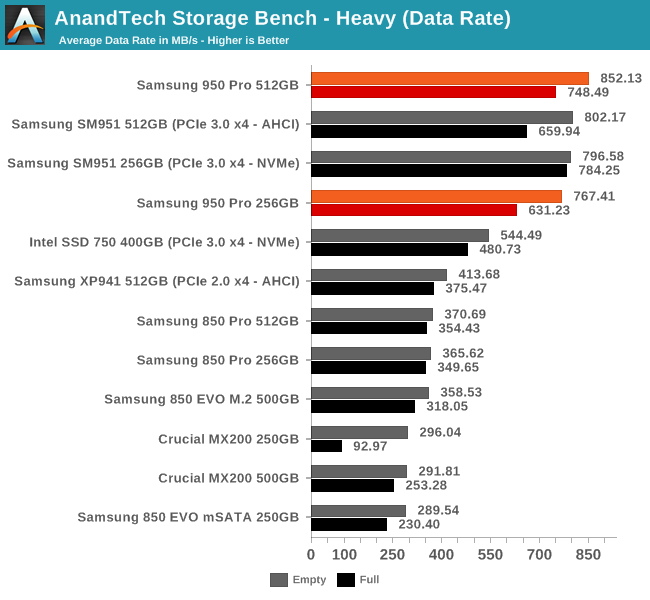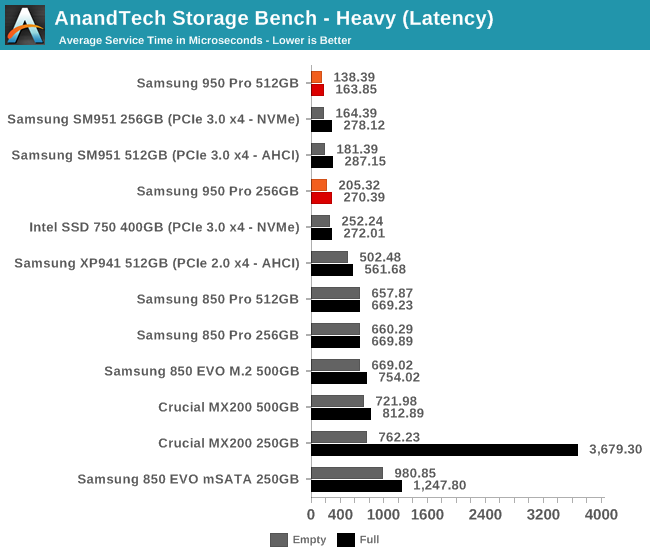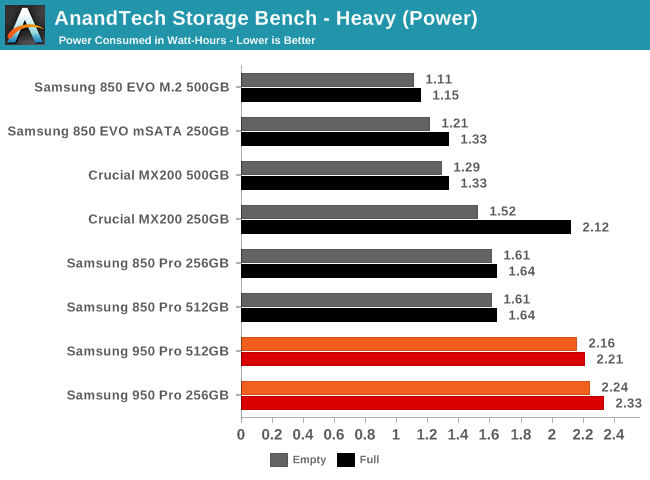The Samsung 950 Pro PCIe SSD Review (256GB and 512GB)
by Billy Tallis on October 22, 2015 10:55 AM ESTAnandTech Storage Bench - Heavy
Our Heavy storage benchmark is proportionately more write-heavy than The Destroyer, but much shorter overall. The total writes in the Heavy test aren't enough to fill the drive, so performance never drops down to the steady state. This test is far more representative of a power user's day to day usage, and is heavily influenced by the drive's peak performance. The Heavy workload test details can be found here.

Performance of the 950 Pro is comparable to the SM951, which is to say that it's significantly better than everything else we've tested. The penalty when starting with a fill drive is a bit larger than normal, but simply being full isn't enough to tank the performance the way a sustained test can.


Average service time and latency outliers are vastly better than any SATA drive, but NVMe doesn't seem to make a huge difference.

The high performance comes with the price of high power consumption, and the total energy used over the course of this test is significantly higher than all the high-performance SATA drives we're comparing against.










142 Comments
View All Comments
Gigaplex - Thursday, October 22, 2015 - link
It's unlikely Samsung is holding back, as the phenomenon is affecting all brands.ddriver - Monday, October 26, 2015 - link
Corporations do price fixing, why not performance fixing.niva - Wednesday, October 28, 2015 - link
It is possible to do performance fixing, but not likely in this case. Enterprise hardware should generally concentrate on endurance, probably using different binning and better memory. I'm sure they can beef up the drivers too and optimize for certain loads. In general they'll get the most sales by selling in greater numbers. Artificially limiting performance so they can make more profit margin on some (much smaller quantities) hardware being sold to enterprise doesn't make sense.That all being said I guess it is possible.
ShieTar - Monday, October 26, 2015 - link
Yes, there is a DRAM cache. The size of it is listed in the table on the first page of the article.Without this, random writes would still be horrible, as overwriting a complete 128KB block whenever the drive is supposed to write down just 4KB leads quickly to the need of reading, deleting & re-writing the blocks, as no unused 128KB-blocks are left.
Laststop311 - Tuesday, October 27, 2015 - link
its just part of how nand cells works. If you need faster speed 3d xpoint is coming to save the day.Per Hansson - Wednesday, October 28, 2015 - link
The DRAM cache is not used to cache writes.It's large size is mainly for the NAND mapping table.
If writes where cached in DRAM the performance of 4KB random writes would of course be waaay higher than what it is.
And quite extreme dataloss would occur in case of power loss.
virtualbigd - Wednesday, December 16, 2015 - link
Can you elaborate on your reliability point above, for Samsung?virtualbigd - Wednesday, December 16, 2015 - link
I know about 840 EVO, is there something else?Samus - Thursday, October 22, 2015 - link
I have my reservations over Samsung drives, especially since the 840 EVO, but DAMN.jay401 - Saturday, October 24, 2015 - link
Hey if you turn that V upside down, you have the first A-NAND SSD. :D